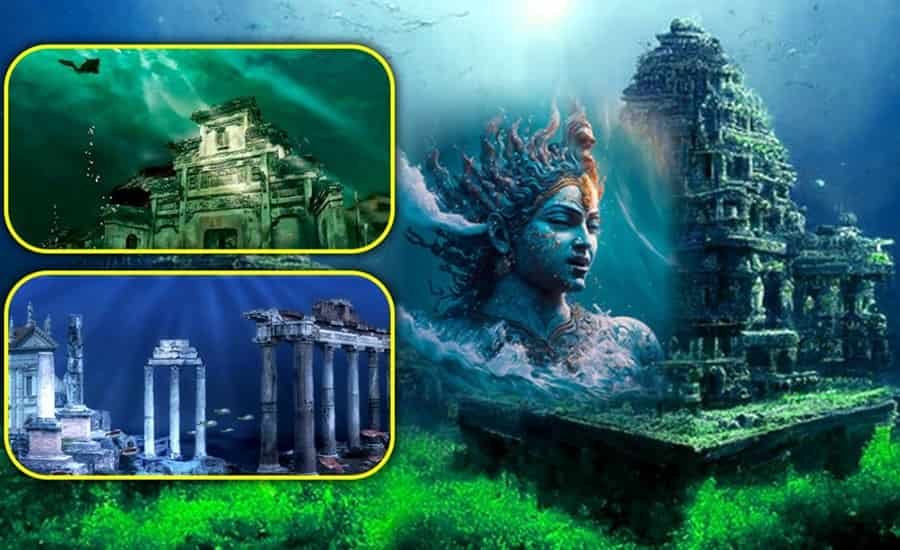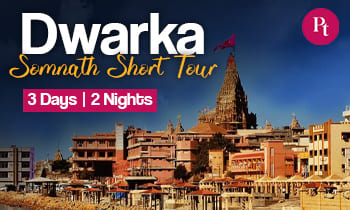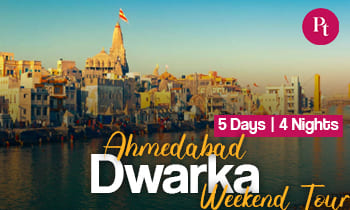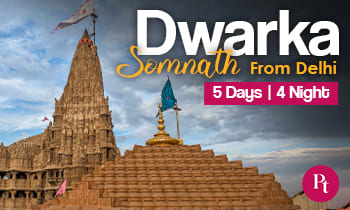The Dwarkadhish Temple, also known as the Dwarka Temple or Jagat Mandir, holds immense significance in Hinduism and is a revered pilgrimage site for followers of the faith. Located in the city of Dwarka in the western Indian state of Gujarat, this temple is dedicated to Lord Krishna, who is worshipped here in his form as the “King of Dwarka” or “Dwarkadhish.”

History
The history of the Dwarkadhish Temple can be traced back to ancient times, and it is believed to have been built around 2,200 – 2,000 years ago. The original structure is said to have been constructed by Lord Krishna’s grandson, Vajranabha, as a tribute to the deity. Over the centuries, the temple has undergone several renovations and rebuilds due to damage caused by natural disasters and invasions.
Archaeological excavations conducted in the Dwarka region have unearthed submerged structures that are believed to be remnants of the ancient city of Dwarka, mentioned in Hindu scriptures like the Mahabharata. These findings have added an archaeological dimension to the temple’s history, reinforcing the belief that Dwarka has a rich cultural and religious heritage.
Mythology
The mythology surrounding the Dwarkadhish Temple is intricately woven into the tales of Lord Krishna. According to Hindu mythology, Dwarka was the capital of Lord Krishna’s kingdom. The city is said to have been established by Lord Krishna after he migrated from Mathura to escape the constant threat posed by his uncle, the tyrant King Kansa.
The construction of Dwarka is believed to be a celestial event, as Lord Krishna summoned the divine architect Vishwakarma to build the city. The mythological narrative suggests that Dwarka was a majestic and opulent city, adorned with grand palaces and divine architecture. The Dwarkadhish Temple, as an integral part of this mythical city, is considered a sacred site where Lord Krishna resided and ruled.
Legends
1- The Killing of Demon Shankhasura
One of the legends associated with the Dwarkadhish Temple involves Lord Krishna’s victory over the demon Shankhasura. It is said that Shankhasura acquired immense powers through penance and became a menace to the gods. Lord Krishna, in his divine avatar, confronted Shankhasura and eventually vanquished him. The conch shell (shankha) held by the demon was taken by Lord Krishna as a symbol of victory, and it is said that the sound of this conch resonates in the temple.
2- Marriage with Rukmini
Another significant legend is related to Lord Krishna’s marriage to Queen Rukmini. It is believed that Rukmini, a devoted follower of Lord Krishna, chose him as her husband through a letter (known as the Rukmini Harana). The Dwarkadhish Temple symbolizes the sacred union of Lord Krishna and Rukmini, and the temple’s architecture and rituals reflect the divine matrimony.
3- The Submersion of Dwarka
A well-known legend is the submersion of the ancient city of Dwarka. As per Hindu scriptures, after Lord Krishna completed his earthly incarnation, Dwarka was submerged into the sea. Pilgrims and scholars alike believe that the current city of Dwarka and the Dwarkadhish Temple stand on the hallowed grounds of the ancient Dwarka, and the temple serves as a connection to the divine past.
Architecture
The Dwarkadhish Temple’s architecture is a blend of Chalukya and Solanki styles, reflecting the cultural and artistic influences of the region. The temple is constructed on a raised platform and has a five-story main structure supported by 72 pillars. The spire, or shikhara, is adorned with intricate carvings and sculptures. The temple’s flag, known as the “Dhvaja,” is changed five times a day, accompanied by chanting and rituals.
The main deity inside the temple is Lord Dwarkadhish, a black idol of Lord Krishna standing in a tribhanga pose (three curves). The sanctum sanctorum is adorned with silver and gold ornaments, and devotees offer prayers and perform aarti to seek the blessings of the deity.
Pilgrimage and Festivals
The Dwarkadhish Temple attracts millions of pilgrims annually, making it one of the Char Dham pilgrimage sites for Hindus. The temple is especially crowded during festivals such as Janmashtami, the birthday of Lord Krishna, when elaborate celebrations and processions take place.
Devotees believe that a pilgrimage to the Dwarkadhish Temple absolves them of sins and ensures a path to salvation. The circumambulation of the temple, known as pradakshina, is a common practice among pilgrims as they seek the divine blessings of Lord Krishna.
Conclusion
The Dwarkadhish Temple stands not only as a testament to the rich religious and cultural history of India but also as a symbol of unwavering devotion to Lord Krishna. Its legends, mythology, and architectural splendor make it a significant pilgrimage destination and a source of spiritual inspiration for millions of believers. As devotees continue to flock to this sacred site, the Dwarkadhish Temple remains a living link between the mortal realm and the divine, echoing the timeless stories of Lord Krishna and the ancient city of Dwarka.
Also Read:




 Call
Call WhatsApp
WhatsApp Enquiry
Enquiry
Dwarka me pani ka problem kyun hai pure water nahi hai